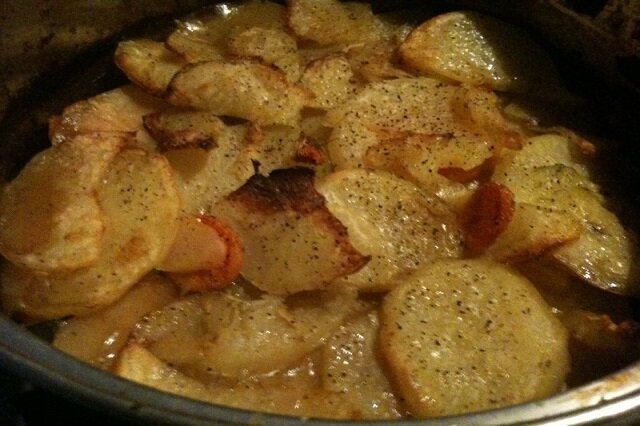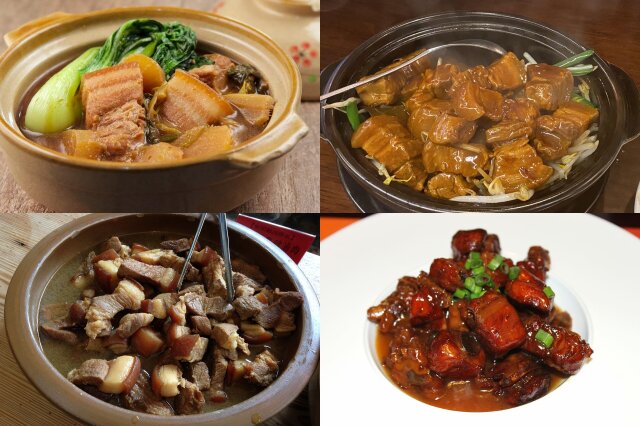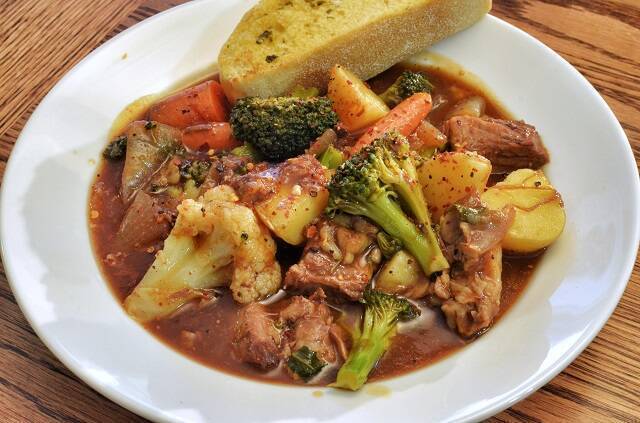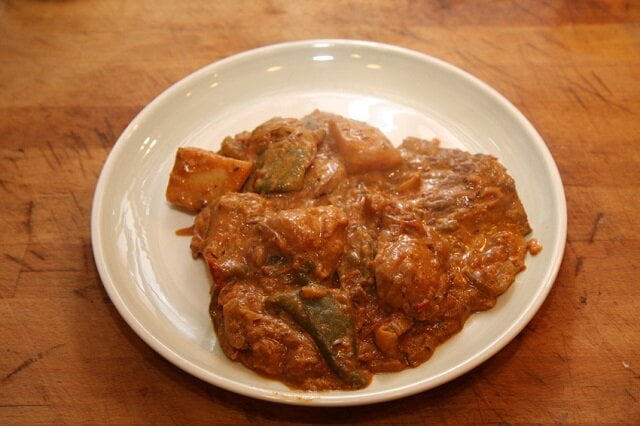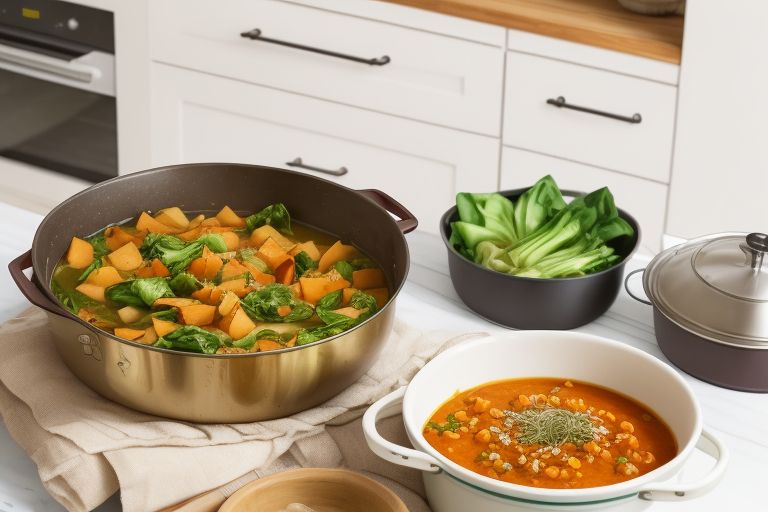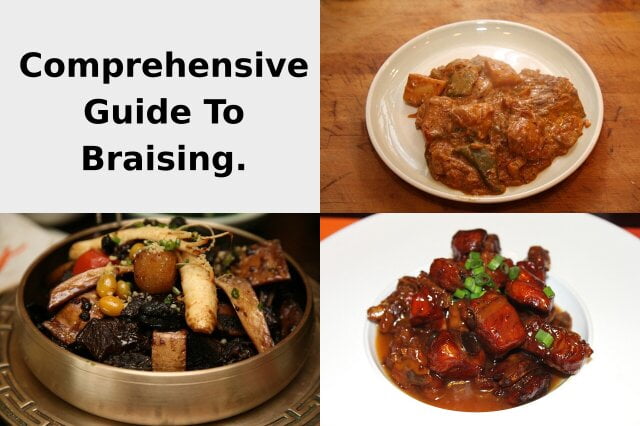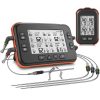What Does Braised Mean?
A Comprehensive Guide
Braising is a cooking technique used to create tender and flavourful dishes.
The process involves slowly simmering meat or vegetables in liquid over low heat for an extended period of time.
This guide will teach all about the braising process, including my recipe for old fashioned braised steak and onions and getting perfect juicy tender results.
This guide answers all your questions about what braised means and how to use it in your cooking.
[lwptoc]
Braised Meaning
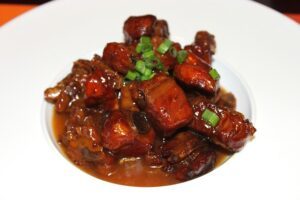 Braising is a cooking technique that involves browning meat or vegetables in a skillet before simmering them in a flavourful liquid for an extended period of time.
Braising is a cooking technique that involves browning meat or vegetables in a skillet before simmering them in a flavourful liquid for an extended period of time.
This method works well for tougher cuts of meat and creates tender and aromatic dishes.
The ingredients are typically cooked over low heat and covered, allowing the slow-cooking process to break down the fibres in the food and produce incredibly rich flavours.
This is done in a covered pan at a braising temperature in the lower heat range on top of a stove or in an oven.
Braised dishes are often cooked for hours, breaking down tough cuts of meat and yielding extremely delicious results.
How Does Braising Work?
As it’s heated, the braising liquid releases steam.
The steam hits the underside of the pot lid, condenses and falls back onto the main ingredient, being your meat or poultry.
This creates a constant cycle that causes the flavours of the liquid and the meat to meld as it slow cooks, giving you an especially tender result by the end of cooking.
Braised to Perfection: 7 Foods You Need to Try
Looking for new ways to cook your favorite foods? Braising is a great option!
Check out our list of 7 foods that are perfect for braising and get ready to impress your taste buds.
- Beef:
Beef is a classic choice for braising. The slow cooking process breaks down the tough fibres in the meat, resulting in a tender and flavourful dish.Some popular beef cuts for braising include chuck roast, brisket, and short ribs.
- Pork:
Pork is another great option for braising. Similar to beef, the slow cooking process helps to tenderize the meat and infuse it with flavour.Pork shoulder, pork belly, and pork chops are all great cuts for braising.
- Chicken:
Braising is a great way to cook chicken, especially tougher cuts like thighs and legs. The slow cooking process helps to keep the meat moist and tender, while also infusing it with flavour.
Chicken braised in wine or tomato sauce is a classic dish. - Lamb:
Lamb is a delicious meat that is perfect for braising. The slow cooking process helps to break down the tough fibres in the meat, resulting in a tender and flavourful dish.Lamb shanks and lamb shoulder are both great cuts for braising.
- Vegetables:
Vegetables can also be braised, resulting in a delicious and flavourful side dish.Some popular vegetables for braising include carrots, onions, and fennel.
Braised vegetables are often served as a side dish or used as a base for soups and stews.
- Fish:
Fish can also be braised, although it requires a delicate touch to avoid overcooking the fish.Some popular fish for braising include salmon, halibut, cod, snapper, barramundi, blue eye trevalla, and hapuku.
These fish have a firm texture and can hold up well to the slow cooking process of braising, resulting in a flavourful and tender dish.
Braised fish is often served with a flavourful sauce or broth.
- Fruit:
Fruit can also be braised, resulting in a delicious and unique dessert.Some popular fruits for braising include apples, pears, and figs.
Braised fruit is often served with ice cream or whipped cream.
Why Braise Meat
Braising breaks down connective tissues in tough cuts of meat, leaving them tender, succulent and can be carved or pulled as you want.
The results of braising are comforting, healthy dishes that retain the nutrients of the ingredients and require no fat.
What are the Different Types of Braises?
Braising can be divided into two categories: brown and white.
- Brown braising:
This is the most common method used these days.
The meat is seared on the outside until it is browned to give it colour and to help develop flavour.
It is then slow cooked in a dark liquid such as beef stock, red wine, tomato juice, etc. - White braising:
In white braising the meat is blanched so that it doesn’t brown.
It is then cooked in a clear or light coloured liquid such as chicken or vegetable stock, white wine, orange juice or beer.
Both types require a low and slow cooking process to allow for the breaking down of tough fibres and create flavourful dishes.
Advantages of Braising
- Enhanced Flavour;
One of the main benefits of braising is that, since the food is cooked slowly in a liquid-based marinade, it develops a fuller flavour.This intense flavour can be altered with various spices and herbs, providing you with tasty braised dishes that are unlike anything else you have cooked before.
The flavours will be elevated and savoured long after each bite. - Increased Nutritional Value;
When using braising methods to cook food, certain vitamins and minerals become naturally enhanced in what you are consuming.The increased water content and slow cooking of the recipe allows for ingredients to maintain more nutrients than when steaming or microwaving them, all while adding luxury to your meal.
- Versatile Cooking Approach;
Braising is a very versatile approach for cooking, as it works particularly well for tough cuts of meat; but also works marvels when applied to any vegetable such as mushrooms or broccoli.You can use different mixtures of herbs and sauces to achieve many types of results.
Whether this is an Italian style pasta dish or a traditional Irish stew – braising caters for all tastes! - All Round Nutrition Of Ingredients;
Additionally, this type of method also brings out multiple nutrients from each component in your ingredient list.Every part of your meal will be nutrient filled which adds to its taste but most importantly it adds increased nutrition onto your plate delivering essential amino acids, proteins and essential minerals.
All this is essential for the upkeep of our health along with other significant vitamins that sustain bodily functions. - Time Saving Method;
Braises may require quite a bit of preparation – such as chopping and slicing vegetables and seasoning the base before placing it onto heat.However once set up they take just minutes per day once started, leaving enough free time for yourself afterwards!
Ideal if you’re keen on preparing ahead ready meals for later consumption! - Budget Friendly Balanced Meals;
Finally, one great benefit when talking about convenience foods is budget effectivity throughout household budgets.
With several low cost ingredients within each recipe you can create complete balanced meals packed full of vitamins and minerals.This makes sure health requirements are met without going above those much desired monthly budgets!!
How to Use Braising in Cooking.
Braising is a great way to cook more budget-friendly cuts of meat.
The moist heat helps break down tough fibres, making them tender and flavourful.
To make braises, start by choosing your protein – this could be something like chicken thighs or pork shoulder.
Then, sear the meat in some hot oil and add liquid until it just covers the meat.
Simmer over low heat for an extended period of time (the longer the better) until the meat is cooked through.
You can add vegetables, herbs, spices and other flavourings to enhance the dish as it cooks.
Serve with your favourite accompaniment for a delicious meal!
Common Ingredients Used in Braised Dishes.
When braising, there are a few common ingredients that you’ll need to have on hand.
Vegetables are often added to a braise to add flavour and texture;
these could include carrots, garlic, onions, celery, mushrooms or any other vegetable of your choice.
Additionally, herbs and spices can be used for flavouring – bay leaves, rosemary, thyme, pepper and oregano are popular choices.
Finally, choose a cooking liquid; this could be anything from white wine or beer to stock or even just water.
You will need to add enough of the cooking liquid so that the ingredients are almost covered.
Can You Overcook A Braise
In a nutshell, yes you can overcook a braise and dry your meat out.
Just because it’s cooked using liquids and steam, doesn’t mean you can’t dry it out.
As to when the dish is done, tenderness is really what you should be looking for more than anything.
It is done when fork tender and pullable.
If the meat is on the bone, the meat should be starting to fall off.
Braising Temperature
Most braising recipes indicate the ideal braising temperature to be between 140°C (284°F) and 170°C (338°F).
I find that starting a braise at 110°C (230°F) and then raising the temperature to 130°C (266°F) after two hours is ideal.
These are also the temperatures I cook our slow cooked pullable roasts at in our smoker.
The Essential Equipment Needed for Perfect Braising
Braising is a delicious way to cook meat and vegetables, but it requires the right equipment.
Learn what you need to get started with this essential list of braising equipment.
- Dutch Oven:
A Dutch oven is a heavy, deep pot with a tight-fitting lid that is perfect for braising. It is made of cast iron or ceramic and can be used on the stovetop or in the oven.The heavy construction of a Dutch oven allows for even heat distribution and retention, making it ideal for slow-cooking tough cuts of meat.
When choosing a Dutch oven for braising, look for one that is made of heavy, durable materials like cast iron or enameled cast iron.
It should have a tight-fitting lid to keep moisture and heat inside, and be large enough to accommodate the size of the meat or vegetables you will be braising.
Handles that are oven-safe and easy to grip are also important for safe and easy handling.
- Cast Iron Skillet:
Cast iron skillets are perfect for braising because they distribute heat evenly and retain heat well, which allows for a consistent and controlled cooking temperature.The heavy weight of the skillet also helps to tenderize tougher cuts of meat, resulting in a delicious and flavourful dish.
Additionally, the skillet can go from stovetop to oven, making it a versatile tool for braising.
When choosing a cast iron skillet for braising, look for one that is heavy and thick-walled, as this will help distribute heat evenly and retain it for a long time.
Make sure it has a tight-fitting lid to keep moisture in, and opt for one with a large surface area to accommodate larger cuts of meat or vegetables.
A skillet with a smooth cooking surface will also make it easier to sear and brown your ingredients before braising.
- Deep Casserole Dish:
A deep casserole dish is ideal for braising because it allows for the meat or vegetables to be fully submerged in the cooking liquid, resulting in a more tender and flavourful dish.The high sides of the dish also help to prevent the liquid from evaporating too quickly, ensuring that the food stays moist and juicy.
Additionally, the heavy construction of most casserole dishes helps to distribute heat evenly, preventing hot spots and ensuring that the food cooks evenly.
When choosing a casserole dish for braising, look for one that is made of a heavy material, such as cast iron or enamel-coated cast iron, as this will distribute heat evenly and retain it well.
The dish should also have a tight-fitting lid to keep moisture in and prevent evaporation.
Just make sure it can go from stovetop to oven and can hold the amount of food you want to braise.
- Stockpot:
A stockpot is ideal for braising because it has a wide base and high sides, allowing for even heat distribution and plenty of room for the ingredients to cook in liquid.The tight-fitting lid also helps to keep moisture and flavor locked in, resulting in tender and flavourful meats and vegetables.
When choosing a stockpot for braising, look for one that is heavy and has a tight-fitting lid to retain moisture.
A pot with a wide base will allow for even heat distribution and browning of the meat.
Additionally, make sure the pot is oven-safe and has sturdy handles for easy lifting.
- Roasting Pan:
A roasting pan is great for braising because it allows for even heat distribution and retains moisture, resulting in tender and flavourful meat.The high sides of the pan also prevent splatters and spills, making it easier to clean up.
Additionally, many roasting pans come with a lid, which helps to trap in heat and moisture for even better results.
When choosing a roasting pan for braising, look for one that is heavy and sturdy, with a tight-fitting lid.
The material should be able to conduct heat evenly, such as stainless steel or cast iron.
Make sure it is large enough to fit your meat comfortably, and has handles that are easy to grip and maneuver.
A non-stick coating can also be helpful for easy cleaning.
- Tongs:
Tongs are an essential tool for braising as they allow you to easily turn and move the meat without piercing it.Piercing the meat can cause it to lose its juices and become dry and tough.
When choosing tongs for braising, look for ones that have a good grip and are long enough to reach into the pot without your hands getting too close to the heat.
Silicone-tipped tongs are great for non-stick pans, while stainless steel tongs are more durable and can handle heavier cuts of meat.
It’s also important to choose tongs that are easy to clean and store.
- Chef’s Knife:
A sharp chef’s knife is necessary for trimming and cutting the meat before braising.
It is also useful for chopping vegetables and herbs that will be added to the braising liquid.When choosing a chef’s knife for braising, look for a blade that is sturdy and heavy enough to handle tough cuts of meat, but also has a sharp edge for precision slicing.
A comfortable handle is also important for a good grip and control while cutting.
- Cutting Board:
A sturdy cutting board is necessary for preparing the meat and vegetables before braising.
It should be large enough to accommodate the size of the meat and have a groove around the edge to catch any juices.When choosing a cutting board for braising, look for one that is large enough to accommodate the size of the meat you will be braising.
It should also be made of a material that won’t dull your knives, such as wood or plastic.
Additionally, make sure it is easy to clean and sanitize to prevent cross-contamination.
- Meat Thermometer:
A meat thermometer is essential for ensuring that the meat is cooked to the proper temperature.
This is especially important for larger cuts of meat that require longer cooking times.When choosing a thermometer for braising, look for one with a probe that can be inserted into the meat and give an accurate reading.
A digital thermometer is recommended, as it will give a quick and precise reading.
Make sure the thermometer has a temperature range that covers the desired cooking temperature for your recipe.
It’s also important to choose a thermometer that is easy to clean and has a durable design.
Using a ChefsTemp Thermometer for Accurate Cooking
A ChefStemp thermometer is the ideal tool for anyone looking to cook accurately and on time.
Using the ChefStemp thermometer helps you determine the optimal temperature for cooking meats, poultry, fish, eggs, and other recipes.With a large LCD display and easy-to-read temperature indicators, it also provides fast and accurate readings for quick results in both Celsius and Fahrenheit.
- ChefsTemp Pocket Pro

- Description:Professional thermocouple probe sensor with 1 second reading time, this pocket size kitchen gadget is suitable for both professional chefs and home cooks. Pocket Pro is another amazing innovation from ChefsTemp. It is a 4-way rotating display thermometer,
- Price: $34.99
- ChefsTemp Finaltouch X10

- Description:Finaltouch X10 is the Winner of Red Dot Product Design in 2022. The Red Dot Design Award is one of the three most prestigious professional design competitions in the world. Winning the award proves its the Leader in Design and Technology. Chefs around the
- Price: $69.99
- ChefsTemp Quad Xpro

- Description:Quad XPro is designed to track temperatures over an extended period of time with moderate-heat cooking methods, such as smoking, oven-roasting, deep-frying, home brewing, and Sous Vide and to be used while grilling.
- Price: $109.99
- Strainer:
A strainer is necessary for removing any solids from the braising liquid before serving.
It can also be used to strain the liquid into a separate container for storage.When braising, you want to choose a strainer that has a fine mesh to catch any small bits of food or impurities.
Look for a strainer with a sturdy handle and a size that fits comfortably over your pot or pan.
A strainer with a hook or rest to hold it in place while you pour is also helpful.
Consider the material of the strainer – stainless steel is durable and easy to clean, while silicone is heat-resistant and won’t scratch your cookware.
- Aluminum Foil:
Aluminum foil is useful for covering the Dutch oven during the braising process.
This helps to keep the moisture in and prevent the meat from drying out.When choosing aluminum foil for braising, look for heavy-duty foil that is at least 18 inches wide.
This will ensure that the foil can withstand the high heat and moisture of braising without tearing or puncturing.
Additionally, consider using non-stick foil or lining the foil with parchment paper to prevent sticking and make cleanup easier.
- Wooden Spoon:
A wooden spoon is useful for stirring the braising liquid and scraping any browned bits from the bottom of the Dutch oven.
This helps to add flavour to the braising liquid.When choosing a wooden spoon for braising, look for one that is sturdy and has a comfortable grip.
Make sure it is made from a hardwood, such as maple or beech, which is durable and won’t absorb flavours or odors.
Also, consider the size and shape of the spoon, as a larger spoon may be better for stirring larger pots of food.
- Oven Mitts:
Oven mitts are necessary for handling the hot Dutch oven when transferring it from the stovetop to the oven.
They should be heat-resistant and provide a good grip to prevent accidents.When choosing oven mitts when braising food, look for mitts that are heat-resistant and have a non-slip grip.
Silicone and neoprene mitts are great options as they can withstand high temperatures and provide a secure grip.It’s also important to choose mitts that fit well and cover your wrists to protect them from steam and hot liquids.
Tips for Mastering the Art of Braising.
Mastering the art of braising doesn’t have to be intimidating!
Here are a few tips to ensure your recipes come out perfect every time.
When choosing your ingredients, pick high-quality vegetables that are in season.
Use flavourful stocks and other liquids to deepen the flavour of the final dish.
This will help tenderise tougher cuts of meat and will also help enhance all the flavours coming together to make a delicious, fully-developed dish.
Braised dishes are often times better when prepared the day before, this waiting period allows the flavours to meld.
In addition, when these dishes are refrigerated, any fat forms on the surface allowing easier removal when reheating.
A successful braise intermingles the flavours of the foods being cooked and the cooking liquid.
Also, the dissolved collagens and gelatins from the meat enrich and add body to the liquid.
Finally, remember that low and slow is the key phrase – cook your dishes over low heat and for a longer period of time.
There are a few ways to infuse flavour into the dish, let’s take a look.
- Dry Brining Your Meat
Season the meat by Dry Curing before pan-searing.
For even more flavour, apply a simple dry rub.
For best results this should be done a few hours or up to a day in advance.
Place it uncovered in the fridge to really soak up the seasoning. - Add Aromatics and Vegetables
Adding traditional aromatics and vegetables such as mushrooms. onions, potato, carrots, celery, and garlic will add sweetness and texture to the dish.
There is no reason why the likes of red or green capsicum, fennel, or chili peppers can’t be added. - Herbs and Spices
Adding spices and herbs such as black peppercorns, red chilli flakes, and bay leaves can also add heat and earthiness.
Try also adding dried herbs, like bay leaves or oregano, or fresh herbs, like parsley or basil, to simmer in the braising liquid. - Braising Liquid
There are many options for braising liquid such as white wine, red wine, meat or vegetable stocks, crushed tomatoes, orange juice, pomegranate juice, apple cider.
You could even use cola or lemonade as a braising liquid.
Remember that a braising liquid with higher sugar content will continue to reduce and caramelise.You can also combine different options, such as a combination of red wine and beef broth.
- Braising is economical, as it allows the use of tough and inexpensive cuts
- Braising is also efficient, as it often employs a single pot to cook an entire meal.
Recipes Using The Braising Method
Here’s my delicious recipes using the braising cooking method, a technique that tenderises tough cuts of meat through long, slow cooking in liquid. Perfect for creating flavourful and comforting dishes.
